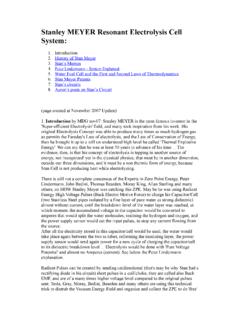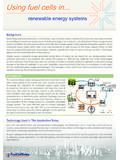Transcription of A REVIEW ON WATER ELECTROLYSIS - CRES
1 A REVIEW ON WATER ELECTROLYSIS Emmanuel Zoulias1, Elli Varkaraki1, Nicolaos Lymberopoulos1, Christodoulos N. Christodoulou2 and George N. Karagiorgis2 1 Centre for Renewable Energy Sources (CRES), Pikermi, Greece 2 Frederick Research Center (FRC), Nicosia, Cyprus Abstract. ELECTROLYSIS is an electrochemical process in which electrical energy is the driving force of chemical reactions. Substances are decomposed, by passing a current through them. The first observation of this phenomenon was recorded in 1789. Nicholson and Carlisle were the first who developed this technique back in 1800 and by the beginning of the 20th century there were already 400 industrial WATER ELECTROLYSIS units in use. As mentioned before, WATER is decomposed to hydrogen and oxygen, by passing a current through it in the presence of suitable substances, called electrolytes. Electric current causes positively charged hydrogen ions to migrate to the negatively charged cathode, where a reduction takes place in order to form hydrogen atoms.
2 The atoms formed then combine to form gaseous hydrogen molecules (H2). On the other hand, oxygen is formed at the other electrode (the positively charged anode). The stoichiometry of the reaction is two volumes of hydrogen to one volume of oxygen. The most important part of the construction of ELECTROLYSIS units is to use adequate electrodes to avoid unwanted reactions, which produce impurities in the hydrogen gas. Another necessary component of such a unit is a separating membrane that allows the passage of ions, or electrons and not oxygen, or hydrogen atoms. This membrane allows the gases to be kept separate in order to avoid the risk of an explosive mixture being formed in the ELECTROLYSIS unit. In the initial discovery of ELECTROLYSIS , an acidic WATER solution was used, but nowadays there is a trend towards alkaline electrolytes such as potassium hydroxide (KOH).
3 This technology offers the advantages of materials which are cheaper and less susceptible to corrosion compared to those required to handle acids. ELECTROLYSIS plants with normal or slightly elevated pressure usually operate at electrolyte temperature of 70-90oC, cell voltage of V and consume 4-5 KWh / m3 of hydrogen, which is obtained at a purity of and more. Pressure ELECTROLYSIS units run at 6-200 bar and there is no significant influence on the power consumption. Because of its high energy consumption and also of the quite substantial investment, WATER ELECTROLYSIS is currently used for only 4% of world hydrogen production. Nowadays research and development into high efficiency electrolysers is flourishing in many areas. A way of improving ELECTROLYSIS units efficiency is by increasing the process temperature which lowers the voltage required to electrolyse the WATER , but also requires more expensive materials.
4 Despite the fact that the total energy needed for the electrochemical decomposition of WATER decreases only slightly with increasing temperature, the reversible part of the energy requirement ( F), which is supplied as electrical energy, decreases considerably. Therefore an increasing amount of the total energy could be supplied as heat. At elevated temperatures (800-900oC) the electric power consumption is approximately only 3 kWh / m3 of hydrogen. It must be noted that this technology is still in the development stage. ELECTROLYSIS is considered as the cleanest way to produce hydrogen, when the required electricity is derived from renewable energy sources. In countries with a lot of waterfalls, hydroelectricity can be used as the energy source for WATER ELECTROLYSIS . Other renewable sources that could be used for supplying ELECTROLYSIS units are solar, aeolic and geothermal energy.
5 Photoelectrolysis, in which the photovoltaic cells are also electrodes that decompose WATER to hydrogen and oxygen gas could be used for the production of hydrogen. These technologies could be used in order to store energy as hydrogen, which can be transformed to electricity in fuel cells, when the natural source of energy is not available. The production of hydrogen through ELECTROLYSIS using renewable energy sources has the smallest impact on the environment. 1. Historical background The history of WATER ELECTROLYSIS started as early as the first industrial revolution, in the year 1800, when Nicholson and Carlisle were the first to discover the ability of electrolytical WATER decomposing. By 1902 more than 400 industrial WATER ELECTROLYSIS units were in operation and in 1939 the first large WATER ELECTROLYSIS plant with a capacity of 10,000 Nm3 H2/h went into operation.
6 In 1948, the first pressurized industrial electrolyser was manufactured by Zdansky/Lonza. In 1966, the first solid polymer electrolyte system (SPE) was built by General Electric, and in 1972 the first solid oxide WATER ELECTROLYSIS unit was developed. The first advanced alkaline systems started in 1978. The history ends up in our days with the development of proton exchange membranes, usable for WATER ELECTROLYSIS units and fuel cells, by DuPont and other manufacturers, due to the developments in the field of high temperature solid oxide technology and by the optimization and reconstruction of alkaline WATER electrolysers [1]. 2. Theory of WATER ELECTROLYSIS The ELECTROLYSIS of WATER is considered a well-known principle to produce oxygen and hydrogen gas. In a schematic of an electrochemical cell is presented. The core of an ELECTROLYSIS unit is an electrochemical cell, which is filled with pure WATER and has two electrodes connected with an external power supply.
7 At a certain voltage, which is called critical voltage, between both electrodes, the electrodes start to produce hydrogen gas at the negatively biased electrode and oxygen gas at the positively biased electrode. The amount of gases produced per unit time is directly related to the current that passes through the electrochemical cell. In WATER , there is always a certain percentage found as ionic species; H+ and OH- represented by the equilibrium equation: : Sketch of an electrochemical cell [2]. H2O (l) H+ (aq) + OH- (aq) (1) Oxygen and hydrogen gas can be generated at noble metal electrodes by the ELECTROLYSIS of WATER : + electrode (anode): 4OH- 2H2O + O2 + 4e- (2a) - electrode (cathode): 2H+ (aq) + 2e- H2 (g) (2b) In case of acidic or basic WATER , the reactions which occur at the electrode interface are slightly different.
8 In WATER ELECTROLYSIS there are no side reactions that could yield undesired byproducts, therefore the net balance is: 2H2O (4e-) O2 + 2H2 (3) The minimum necessary cell voltage for the start-up of ELECTROLYSIS , Eocell, is given under standard conditions (P, T constant) by the following equation: Eocell=nFGo (4) where Go is the change in the Gibbs free energy under standard conditions and n is the number of electrons transferred. In the case of a closed electrochemical cell, the conditions slightly change from standard conditions, open cell (P, T) = constant to closed cell (V, T) = constant because the change in the cell volume is smaller compared to that of pressure. Therefore, instead of Go, Ao free energy (Helmholtz) is used. The necessary voltage for an electron to overcome the Helmholtz energy barrier is given below: Eocell=nFAo (5) = R n - T So (6) For the ELECTROLYSIS of WATER , the standard reaction enthalpy is, = (kJ/mol), n = , So(H2) = , So(O2) = , So(H2O) (l) = 70 J/mol K, Sotot = + 70 = J/mol K, and = (kJ/mol).
9 So, the minimum necessary cell voltage is Ecell = V. In the case of an open cell, Eocell = - Go/ nF = V, with Go = So = kJ/mol (standard conditions, 1 bar, 25 oC). In order for a reaction to get started, it is necessary to overcome an (extra) energy barrier, the activation energy Eact. The number of molecules able to overcome this barrier is the controlling agent of the reaction rate, r, and it is given by the statistical Maxwell Boltzman relation which has an exponential behaviour: r ~ro exp(-Eact/RT). So, the activation energy expresses the speed with which a reaction takes place. The maximum possible efficiency of an ideal closed electrochemical cell is defined by the following equation: max = = -cellnFE (7) In reality, the efficiency of an electrochemical cell is given by: real = -elecn (8) where Eelec is the voltage to drive the electrochemical cell at I: Eelec = + IR + (9) Where R is the total ohmic series resistance in the cell including external circuit resistance, electrolyte, electrodes, membrane material; is the sum of the overpotentials (activation overpotential at the two electrodes, and the concentration overpotential due to the mass transport of the gaseous products away from the anode and cathode surfaces).
10 The balance energy, per mole, during WATER ELECTROLYSIS is shown in The activation overpotential increases by increasing the current density and can be lowered by using electrodes which have a catalytic action, such as platinum. : Energies involved in a reaction [2]. For WATER ELECTROLYSIS , under ideal reversible conditions, the maximum theoretical efficiency with respect to the electrical energy source would be max = 120%. Therefore, heat would have to flow into the cell from the surroundings. When the value of the denominator in becomes nF (overpotential of ), the electrochemical cell would perform at 100% efficiency. Under these conditions ( S = 0, = 0, so G = ), the cell does not heat or cool and the value of tn = / nF = V is denoted as the thermoneutral potential. The electrochemical cell produces heat at potentials above V and takes heat in at potentials below this value, under the condition that cell temperature is to be maintained constant.












